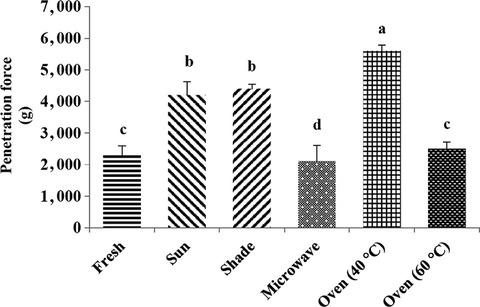当前位置:
X-MOL 学术
›
Food Sci. Nutr.
›
论文详情
Our official English website, www.x-mol.net, welcomes your
feedback! (Note: you will need to create a separate account there.)
Different drying methods of Pistacia Atlantica seeds: Impact on drying kinetics and selected quality properties.
Food Science & Nutrition ( IF 3.5 ) Pub Date : 2020-05-20 , DOI: 10.1002/fsn3.1582 Negar Yarahmadi 1 , Mohammad Hojjatoleslamy 1 , Leila Sedaghat Boroujeni 1
Food Science & Nutrition ( IF 3.5 ) Pub Date : 2020-05-20 , DOI: 10.1002/fsn3.1582 Negar Yarahmadi 1 , Mohammad Hojjatoleslamy 1 , Leila Sedaghat Boroujeni 1
Affiliation

|
The effect of different drying procedures on the quality characteristics of Pistacia atlantica subsp. kurdica is addressed in this work. Using five different drying methods include microwave, oven (40 and 60°C), sun, and shade, P. atlantica were dried. The variations in moisture content, drying rate, major components of essential oil, and texture property were assessed at the start and at the end points of the drying process. Comparison of the drying methods indicated that microwave drying to be most effective in lowering moisture content, while the shade drying had the lowest rate among methods. In the case of microwave, the dried seeds had highest brittleness, while the highest score for the penetration force was observed in oven 40°C. Regarding major elements of the essential oil (α‐pinene, α‐terpinen‐4‐ol, myrcene, β‐ocimene, β‐caryophyllene, and limonene), there were no significant differences between the five drying techniques, nor compared to the fresh sample. To model the drying process, six thin‐layer drying kinetic models were chosen. It was found that the Midilli–Kucuk model was the most suitable for explaining the drying curve of oven 40 and 60°C, microwave, and sun methods; Wang and Singh model was excellent to explain thin‐layer shade drying behavior of the P. atlantica seeds. In conclusion, in this study, an opportunity is represented to apply the most effective procedures to decrease the drying period and to achieve a product with appropriate safety and quality features.
中文翻译:

大西洋黄连木种子的不同干燥方法:对干燥动力学和选定质量特性的影响。
不同干燥程序对黄连木品质特性的影响库尔迪卡在这项工作中得到了解决。使用五种不同的干燥方法,包括微波炉、烤箱(40 和 60°C)、阳光和阴凉处,对大西洋 P. atlantica进行干燥。在干燥过程开始和结束时评估水分含量、干燥速率、精油主要成分和质地特性的变化。各种干燥方法的比较表明,微波干燥降低水分含量最有效,而阴凉干燥的降低率最低。在微波情况下,干燥的种子具有最高的脆性,而在 40°C 的烤箱中观察到穿透力的得分最高。关于精油的主要成分(α-蒎烯、α-萜品烯-4-醇、月桂烯、β-罗勒烯、β-石竹烯和柠檬烯),五种干燥技术之间没有显着差异,也与新鲜的相比没有显着差异。样本。为了模拟干燥过程,选择了六种薄层干燥动力学模型。发现Midilli-Kucuk模型最适合解释烤箱40和60°C、微波和日晒方法的干燥曲线; Wang 和 Singh 模型很好地解释了P. atlantica种子的薄层阴干行为。总之,在这项研究中,有机会应用最有效的程序来缩短干燥时间并获得具有适当安全和质量特征的产品。
更新日期:2020-05-20
中文翻译:

大西洋黄连木种子的不同干燥方法:对干燥动力学和选定质量特性的影响。
不同干燥程序对黄连木品质特性的影响库尔迪卡在这项工作中得到了解决。使用五种不同的干燥方法,包括微波炉、烤箱(40 和 60°C)、阳光和阴凉处,对大西洋 P. atlantica进行干燥。在干燥过程开始和结束时评估水分含量、干燥速率、精油主要成分和质地特性的变化。各种干燥方法的比较表明,微波干燥降低水分含量最有效,而阴凉干燥的降低率最低。在微波情况下,干燥的种子具有最高的脆性,而在 40°C 的烤箱中观察到穿透力的得分最高。关于精油的主要成分(α-蒎烯、α-萜品烯-4-醇、月桂烯、β-罗勒烯、β-石竹烯和柠檬烯),五种干燥技术之间没有显着差异,也与新鲜的相比没有显着差异。样本。为了模拟干燥过程,选择了六种薄层干燥动力学模型。发现Midilli-Kucuk模型最适合解释烤箱40和60°C、微波和日晒方法的干燥曲线; Wang 和 Singh 模型很好地解释了P. atlantica种子的薄层阴干行为。总之,在这项研究中,有机会应用最有效的程序来缩短干燥时间并获得具有适当安全和质量特征的产品。











































 京公网安备 11010802027423号
京公网安备 11010802027423号